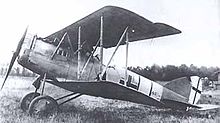|
Jagdstaffel 5
   HistoryRoyal Prussian Jagdstaffel 5, commonly abbreviated to Jasta 5, was created on 21 January 1916,[1] and mobilized on 21 August 1916, as one of the first fighter units of the Luftstreitkräfte, the air arm of the Imperial German Army during World War I. Many of the first pilots of the Jasta came out of KEK Avillers, itself an early attempt to organize and utilize fighter planes as winged weapons. Jasta 5 began its service career at Bechamp near Verdun, in support of 5 Armee. On 29 September 1916, it moved to the Somme to the 1 Armee area of operations. On 11 March 1917, Jasta 5 moved into Boistrancourt; it spent the next year operating from there, in support of the 2 Armee. In March 1918, the Jasta was joined by Jasta 46 thus forming the beginning of Jagdgruppe 2; the new JG was commanded by Flashar, along with his command of the Jasta. In July, command passed to Otto Schmidt; in August, it was joined in the JG by Jasta 34 and Jasta 37. With approximately 253 victories at war's end,[2] Jasta 5 had the third-highest victory total of any squadron in the Luftstreitkräfte. Its casualties came to 19 pilots killed in action, 3 killed in flying accidents, 8 wounded in action, and 1 injured in an accident.[3] Commanding officers
Duty stations (airfields)
Personnel   There were several notable pilots and flying aces who served and scored with Jasta 5. Pilots earning Prussia's highest decoration for valor, the Pour le Mèrite ("Blue Max") who served at one time or another in Jasta 5 included (alphabetically):[2]
Könnecke and Rumey were two of the three members of the "golden triumvirate", who were responsible for 40% of the total victories of the Jasta. The third member of the triumvirate not listed is Josef Mai, who although nominated and eligible for the award, was not officially awarded the Pour le Mèrite prior to the end of hostilities. One member of Jasta 5 was rocket expert Rudolf Nebel.[citation needed] Aircraft and operations The squadron was originally equipped with Fokker Eindeckers. It progressed to use of Albatros D.IIs and Halberstadt D.IIs. In 1917, it was using Albatros D.IIIs and Albatros D.Vs. In 1918, it used both the Fokker D.VII and the Fokker Triplane. At one time, the Jasta was one of only three squadrons not belonging to a Jagdgeschwader (fighter wing) that was totally equipped with the Triplane.[3] It also reputedly operated the Pfalz D.XII,[1] which entered service in July 1918.[4] References
Bibliography
External links
|
||||||||||||||||||||||
